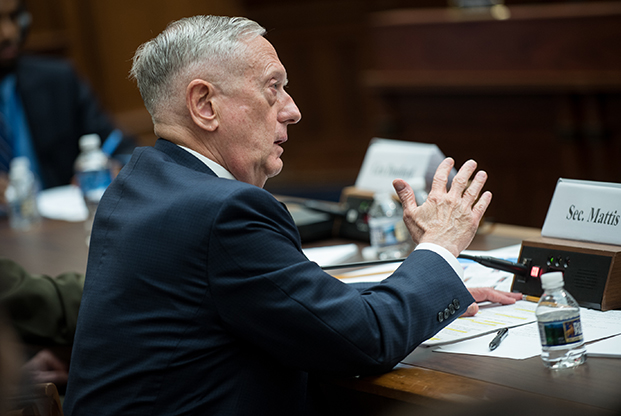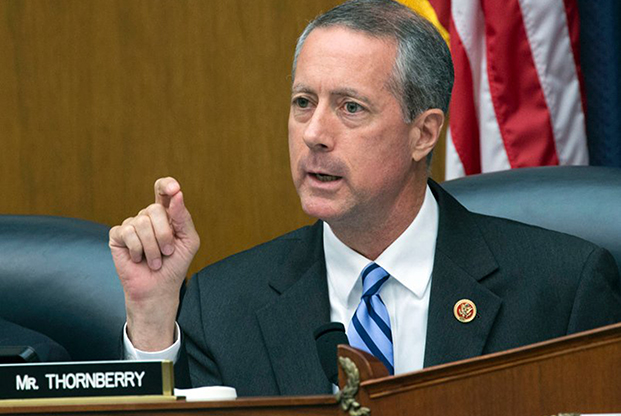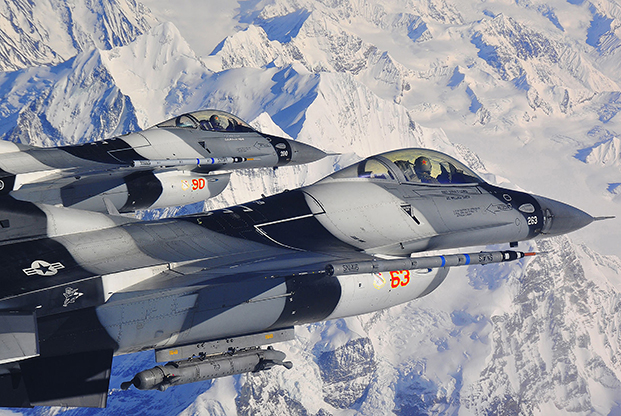
The A-10 has starred in many back-and-forth debates between USAF and Congress. USAF photo
For quite some time, the Air Force has had, at best, a strained relationship with Congress. Lawmakers complain that USAF frequently surprises them with major changes—system retirements, mission or organizational swaps, programmatic cost jumps, and altered relationships with the Guard and Reserve, to name a few—while USAF leaders in turn express frustration that Congress won’t give them a reliable budget or let them manage a resource-strapped force in the most efficient way available.
Things appear to be getting a bit better, but there’s still a long way to go in improving the relationship.
The strain was on full display in the recent back-and-forth over some lawmakers’ plans to create a new Space Corps; an organization patterned after the Marine Corps, but part of the Air Force, with space as its sole focus. Members complained that this new organization was needed because the Air Force just wasn’t paying enough attention to space, the US was falling behind Russia and China in this domain, and military space needs were losing out in the resource competition with more traditional USAF missions.
The Air Force only got wind of this idea in a low-key press release from the House Armed Services subcommittee. The service got to work trying to dissuade lawmakers from going ahead with the plan.
USAF leaders argued that creating a separate organization would only hinder efforts to integrate space into the joint combat enterprise. It would do more harm than good, they said, and it would create a new and expensive bureaucracy. In any event, USAF had just created a new deputy chief of staff for space operations, and this was evidence that the service was already making space a top priority.

Air Force Chief of Staff David Goldfein says breaking off into a new space domain would actually slow the Air Force down. Scott Ash/USAF
House lawmakers remained skeptical. With staggering speed, the proposed change—which never had a public hearing or study—reached the highest levels of the powerful Armed Services Committee.
Within the House, there was little opposition, and even less debate, about what would amount to a radical shift in the structure of the Air Force.
Committee leaders shepherded the provision through the panel’s marathon consideration of the massive Pentagon policy bill in June. Later, on the House floor, the Space Corps idea got barely a few minutes’ mention.
As the Senate’s version of the bill took shape, the notional Space Corps became a lightning rod during consideration of the defense authorization bill. Air Force Secretary Heather Wilson, a former Republican congresswoman from New Mexico, was thrust into a bruising battle with her former colleagues on the Armed Services panel.
Within the Senate, Space Corps was always dead on arrival. The typically more circumspect committee had no appetite for creating a new military service—much less a new position on the Joint Chiefs—without ample study and review. But even with strong Senate opposition to the House language, the Air Force didn’t walk away from the debate unscathed.
During House-Senate negotiations on the final defense authorization measure, lawmakers agreed to kill the newly created deputy chief of staff for space position, sending a strong message to Air Force leadership that their planned internal changes weren’t sufficient. They also kept the prospect of a new space organization alive by adding language mandating a review by the Deputy Secretary of Defense. The conference wanted to know if an all-new military space service—not just a Corps within the Air Force—is needed to deal with space.
The episode drew the contentious Hill-Air Force relationship into high relief. It represents the latest test of service leaders’ ability to maneuver dicey political and policy issues in what’s proving to be, as the Air Force might say, a “contested environment.”

Defense Secretary James Mattis says now is the time for another BRAC round. MSgt. Ken Hammond
CULTURE WARS
The tension between the executive and legislative branches is healthy and natural. Congress has the power of the purse, and military leaders are charged with providing lawmakers with their best military advice. The two don’t always align.
“This is not something that should necessarily frustrate people in the leadership of our Air Force, and I know that it doesn’t,” said former USAF Chief of Staff, retired Gen. Norton A. Schwartz. “There is a recognition that this is the arrangement, this is the architecture we work with. It’s embedded in our Constitution. That is the reality.”
The relationship between the military services and lawmakers is complicated by the fact that those in uniform are not allowed to lobby Capitol Hill. Ultimately, executive branch decisions on policy and spending are far above the pay grade of the service chiefs and secretaries and come directly from the White House.
Even so, USAF’s relationship with the Hill has often seemed more fraught than that of the other services. In an effort to remedy that, USAF leaders have sought to be more forthcoming with key lawmakers.
Robert Winkler, who recently left the Air Force’s legislative liaison office, said there was a conscious decision in the last two years to get Congress involved in decision-making before the release of the annual budget request.
USAF officers, Winkler said, are still giving Congress their best military advice, but doing so with better knowledge of the dynamics on Capitol Hill and better appreciation for potential pitfalls along the way.
In its Hill strategy, the Air Force is also talking to Congress less about dollars and more about combat requirements. That means less time spent talking about a particular budget decision and more on what the service needs to execute worldwide operational demands.
“We have a requirement for a certain force structure, so let’s explain that force structure to the Hill and why we need that requirement, as opposed to those decisions baked in” to the budget request, Winkler said.
Such an approach mollifies hawkish lawmakers, who have long been frustrated with military leaders couching needs in vague discussions of “acceptable levels of risk.” Some decisions derived from that thinking—such as efforts to retire the A-10 and U-2—have been extremely unpopular with Congress, which rejected them.
The new approach “would give Congress pretty much exactly what they’ve been asking for, not just the Air Force but DOD writ large,” said Mark Gunzinger of the Center for Strategic and Budgetary Assessments.
All too often, he noted, the Air Force tells Congress what it can afford, not what it needs to fully implement the national defense strategy, from ongoing operations to deterring potential adversaries such as Russia and China.
The Navy, by comparison, is better at articulating the strategic need for a 355-ship fleet, even if funding for a fleet of that size is unlikely.
“Congress deserves to know what the data points are,” says Gunzinger, a retired Air Force colonel and a former Defense Department official. “Here’s a force we can afford to build given a budget we’ve authorized and appropriated.”
That, in turn, could give Congress the information it needs to make better strategic choices on the size, shape, and nature of the force, he added.
Schwartz, who now leads the Washington-based Business Executives for National Security, rates the Air Force-congressional relationship as “okay” right now. While the Space Corps issue was clearly contentious, there has generally been consensus on other recent issues, such as the need to grow the Air Force and invest more heavily in modernization.
Schwartz took on the top uniformed USAF job at a particularly challenging time for the service, coming in right after the previous Chief and Secretary were fired. He acknowledges that the Air Force is not the favored service among members of Congress. That distinction has typically gone to the Marine Corps.
“I think there’s a consensus that the Marine Corps has the best overall stock on Capitol Hill,” Schwartz said. “They are very skillful in cultivating their brand, and … they are quite good with their congressional relations.”

House Armed Services Committee chairman Rep. Mac Thornberry (R-Texas), like most members of Congress, isn’t sold on another round of BRAC. Sgt. James McCann/Army
ALWAYS FAITHFUL
Working in its favor is the Marine Corps’ smaller size and less diverse portfolio versus the Air Force. That means there’s plenty of opportunity for USAF to make political mistakes that could hurt the service’s brand and its footing inside the Beltway.
“The jobs of the Chiefs and the Secretary in the Washington setting are a lot like a checkbook,” Schwartz said, crediting former Air Force Secretary Michael B. Donley with the analogy. “You make deposits and you make withdrawals, and ideally your deposits exceed your withdrawals. When the latter happens, the other way around, there’s a lot more tension.”
The Marine Corps commandant, meanwhile, tends to have more personal power within his own service than the Army or Air Force Chiefs, Schwartz said.
The Marines also have an alumni network that is “beyond compare,” Schwartz says, and a culture that is more cohesive than in one of the larger services, where “tribal dynamics” sometimes present a political challenge.
Those tribal dynamics were on display when the Air Force sent Congress a proposal five years ago making significant cuts to the Air National Guard. The proposal was rejected by lawmakers, who in turn created a commission on the size and structure of the Air Force, including its reserve components.
Todd Harrison of the Center for Strategic and International Studies aid the Air Force analysis supporting its decisions on the Air Guard—as well as its analysis on other matters—is viewed as suspect by congressional committees.
“In many cases, the Air Force will make a decision and then come up with analysis that supports the decision,” he said. “It makes one question the validity of the analysis.”
Harrison also pointed to a culture of risk aversion within the Air Force senior leadership. As a result, Harrison said, they stick firmly to talking points, making them look disingenuous or even uncooperative when testifying or speaking to members.
“They don’t do as good a job [at] being just candid, both in public settings and in private settings,” added Harrison, a former Air Force reservist.
By comparison, the Marine Corps is akin to a religion, and there is an innate sense of enthusiasm that goes along with that.
“They view themselves as Marines, first and foremost,” Harrison insisted, “and so from that kind of culture, it’s more natural … to just speak off the cuff. They don’t have to stick to talking points because it’s ingrained in them.”

Eielson AFB, once targeted for near-closure, has become a world-class test and training environment. It is home to F-16s (above) and in the future will also have F-35s. SSgt. Christopher Boitz
LESSONS LEARNED
After four years in the chief’s chair, Schwartz said his advice to Air Force leaders on congressional relations is to never surprise a lawmaker. Inform Congress whenever possible, even if that conversation is off the record, he said.
But the communication is a two-way street. The service’s leaders should also have a sense of what the momentum is on Capitol Hill. If the service’s proposals run counter to that momentum, it’s imperative to have a good argument and a good reason for them.
“If you do it right, no one gets surprised,” Schwartz said. “You understand what the boundaries are, you get a sense of what people’s bottom lines are, and you do your best to govern.”
Having those discussions—and including Congress in the analysis before the budget drop—doesn’t necessarily mean the Air Force will get its way. In the end, though, it could make it easier for the Air Force to convince Congress to authorize unpopular proposals such as retiring the A-10 fleet, something the service tried and failed to do for several years.
“You’re in a much better position to fight that fight if you know that you’re fighting the good fight,” Harrison said.
Lawmakers are motivated by different interests than the services. They have constituencies to represent and local interests to protect. That makes policy issues like base closures or aircraft retirements a difficult sell among lawmakers whose states and districts could stand to lose from the decision.
Winkler, however, said he was “pleasantly surprised” that lawmakers—particularly those on the defense committees—could usually see beyond the parochial on proposals affecting national security.
“I found that, for the most part, when faced with the decision of what was best for America, specifically inside the committees, … everybody understood what the big picture was and there wasn’t a big uproar about local politics,” he noted.
Checks and balances in government is a good thing, Schwartz said, allowing that the Air Force may not always be right.
“You come up with a solution set. It is examined every which way by the professional staff and the members, as it should be,” he said. “And the scrutiny is healthy.”
If lawmakers are operating purely on parochial interests, Schwartz said, that’s usually very evident. “But in most cases, it’s not just that. It’s a genuine concern,” he added.
The retired four-star readily acknowledged that his successors handled the politically fraught Air Guard issue better than he did during his tenure as chief. Schwartz also allowed that the 2012 proposal to move F-16 fighters out of Eielson Air Force Base in Fairbanks to JB Elmendorf-Richardson in Anchorage—a move that provoked strong local opposition in Fairbanks and spurred Alaska’s senators to work to block the move—would have been the wrong move for the Air Force.
Three years after USAF made the initial proposal, Schwartz’s successors decided to keep the F-16 squadron in Fairbanks, pointing to the base’s strategic location. The following year, the Air Force announced that Eielson would also become home to two F-35A squadrons, calling it both a strategically important location and a “world-class training environment.”
“The approach we were taking was flawed, to some degree,” Schwartz recalled of the F-16 proposal.
The Air Force will, no doubt, relearn many of these lessons when it defends its Fiscal 2018 budget proposal before the congressional defense committees in the coming months. Lawmakers will, as always, pick apart the budget request, questioning plans to change force structure or reduce planned equipment purchases.
Issues such as base closures and readiness will also likely continue to dominate the debate on defense spending, and the Air Force will definitely not get everything it wants.
“One always has to have a bit of humility,” Schwartz said.
_
Megan Scully is a reporter for CQ Roll Call and a longtime Air Force Magazine contributor.
